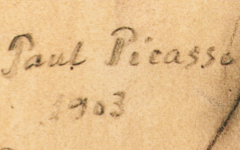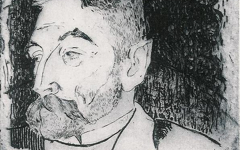Gauguin’s Loss of Virginity (1890-1)

Gauguin, Loss of Virginity or Girl with a Fox (1890-1) Chrysler Museum, Norfolk, VA
Click image to enlarge.
Gauguin's important painting from 1890 known as Loss of Virginity or Girl with a Fox is full of symbolism. Scholars write about it but no-one to my knowledge has yet recognized the most important fact: the fox with the furry paw is Gauguin.
Click next thumbnail to continue

Left: Detail of Gauguin's Loss of Virginity (1890-1)
Right: Detail of Gauguin's Self-portrait with Emile Bernard (1888), inverted
Click image to enlarge.
As the artist grew older, the eyes in his self-portraits grew narrower, his pupils furtively looking to the side. The self-portrait here (near left) was painted two years before the fox.
Click next thumbnail to continue

Left: Detail of Gauguin's Loss of Virginity (1890-1)
Right: Detail of Gauguin's Self-portrait (1893-4)
Click image to enlarge.
In this slightly later self-portrait (near left) his eyes burn green with a passion and intensity again similar to his lupine self-representation.
Click next thumbnail

Left: Detail of Gauguin's Loss of Virginity (1890-1)
Right: Detail of Gauguin's Self-portrait after Les Miserables (1888)
Click image to enlarge.
This last comparison, like the first, pre-dates the fox. The artist's eyes are so caricatural that they begin to look animalistic or leaf-shaped. We have shown elsewhere how Gauguin painted his "self-portrait" as a plant. In this instance, though, there is an added element: the animal/artist's extended furry leg is a metaphor for his hairy paintbrush.
Click next thumbnail to continue
More Works by Gauguin
Notes:
Original Publication Date on EPPH: 02 Nov 2011. | Updated: 0. © Simon Abrahams. Articles on this site are the copyright of Simon Abrahams. To use copyrighted material in print or other media for purposes beyond 'fair use', you must obtain permission from the copyright owner. Websites may link to this page without permission (please do) but may not reproduce the material on their own site without crediting Simon Abrahams and EPPH.




